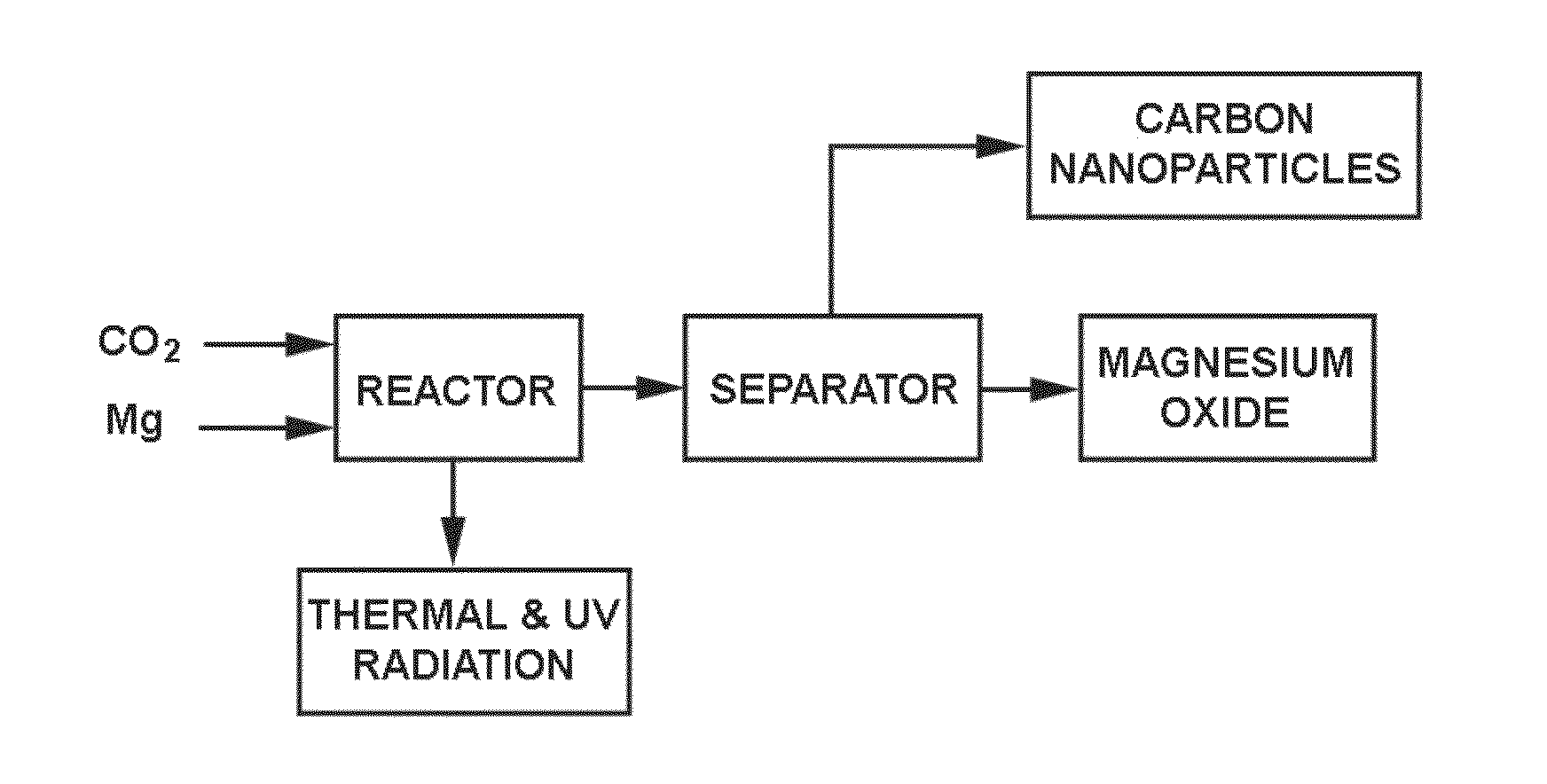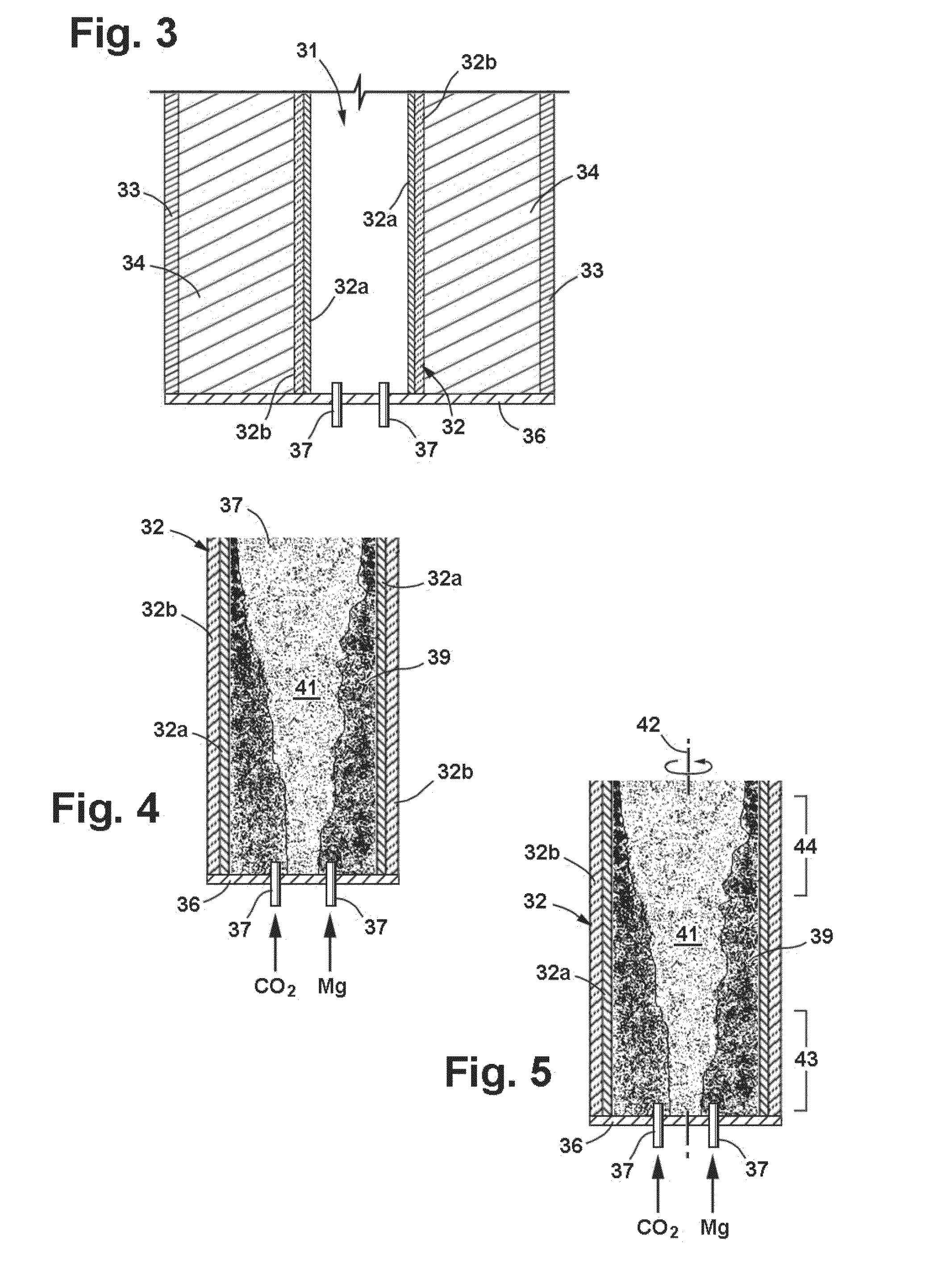Nanomaterials and Process for Making the Same
a technology applied in the field of nanomaterials and process for making the same, can solve the problems of difficult realization of commercial production of graphenes, limited and disadvantageous known graphene formation processes, and no process for carbon nanomaterial production has been successfully commercialized, etc., to achieve the effect of preserving, capturing and utilizing as much of the exothermic energy of reaction
- Summary
- Abstract
- Description
- Claims
- Application Information
AI Technical Summary
Benefits of technology
Problems solved by technology
Method used
Image
Examples
example 1
[0132]A reactor was constructed using two blocks of solid CO2, more commonly known as dry ice. A cavity was drilled in one of the dry ice blocks to serve as a reactor vessel, and the other block was used as a cover. Magnesium bar stock was machined into chips which were placed in the cavity and ignited with a propane torch, following which the cover block was immediately placed on top of the first block. The reaction product, a mixture of white and black crusty powder, was collected and sent out for analytical testing. A second sample was prepared in a similar manner and treated with deionized water and hydrochloric acid (HCl) before being sent out for testing.
[0133]The test results showed that the reaction product consisted of nanomaterial and that the nanomaterial consisted of two dominant morphologies as well as some less frequently observed morphologies. The two dominant morphologies were a clear, irregularly shaped, flat particle showing classic evidence of graphitic (carbon) c...
example 2
[0137]A reactor was constructed from blocks of solid CO2, or dry ice, which were approximately 12 inches square and 1¾ inches square. A cavity having a diameter of approximately 1⅝″ was drilled into one of the blocks to serve as the reactor chamber. Exhaust pressure release vents having a diameter on the order of ¼ inch were drilled laterally from the outer edges of the block to the cavity. The second block was used as a lid for the reactor.
[0138]Magnesium bar stock believed to have a purity of 99% was machined into several batches of various sized flakes. Approximately 10 grams of magnesium chips of between number 5 and number 10 sieve mesh (2.00-4.00 mm) were placed in the cavity. The flakes were ignited with an oxygen-hydrogen torch and the dry ice lid was immediately place on the lower block. The reaction was observed to be extremely vigorous producing a sizable amount of light and resulting in some ejection of white smoky (MgO) material from the edges of the two blocks. The rea...
example 3
[0148]Magnesium barstock was machined into chips ranging in size between about 2.0 and 4.0 mm (sieve mesh sizes #5-#10). These chips combusted with CO2 in a manner similar to that in Example 2, and two samples were prepared for separation processing.
[0149]As an initial step in the post reaction separation processing, the heterogeneous product samples were ground to a 140 mesh size to reduce agglomeration and provide more uniform samples with greater surface area for fluid treatment. The ground up samples were introduced into a vessel containing deionized water and were processed ultrasonically at 20 kHz and 500 Watts for a defined period of time to further reduce particle size and increase surface area. Thereafter, 12M (moles per liter) HCl was added to dissolve the MgO reaction product as well as any remaining uncombusted Mg. The HCl reacted with MgO and Mg to form MgCl2 in an exothermic reaction. The vessel was allowed to cool, following which the sample was treated with HCl again...
PUM
| Property | Measurement | Unit |
|---|---|---|
| temperature | aaaaa | aaaaa |
| composition | aaaaa | aaaaa |
| shape | aaaaa | aaaaa |
Abstract
Description
Claims
Application Information
 Login to View More
Login to View More - R&D
- Intellectual Property
- Life Sciences
- Materials
- Tech Scout
- Unparalleled Data Quality
- Higher Quality Content
- 60% Fewer Hallucinations
Browse by: Latest US Patents, China's latest patents, Technical Efficacy Thesaurus, Application Domain, Technology Topic, Popular Technical Reports.
© 2025 PatSnap. All rights reserved.Legal|Privacy policy|Modern Slavery Act Transparency Statement|Sitemap|About US| Contact US: help@patsnap.com



